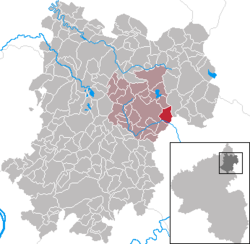Gemünden, Westerwaldkreis
| Gemünden | ||
|---|---|---|
|
||
| Coordinates: 50°33′32″N 08°01′04″E / 50.55889°N 8.01778°ECoordinates: 50°33′32″N 08°01′04″E / 50.55889°N 8.01778°E | ||
| Country | Germany | |
| State | Rhineland-Palatinate | |
| District | Westerwaldkreis | |
| Municipal assoc. | Westerburg | |
| Government | ||
| • Mayor | Dietmar Wolf | |
| Area | ||
| • Total | 5.19 km2 (2.00 sq mi) | |
| Elevation | 315 m (1,033 ft) | |
| Population (2015-12-31) | ||
| • Total | 1,028 | |
| • Density | 200/km2 (510/sq mi) | |
| Time zone | CET/CEST (UTC+1/+2) | |
| Postal codes | 56459 | |
| Dialling codes | 02663 | |
| Vehicle registration | WW | |
Gemünden is an Ortsgemeinde – a community belonging to a Verbandsgemeinde – in the Westerwaldkreis in Rhineland-Palatinate, Germany.
Gemünden lies east of Westerburg, in a valley setting shielded by mountains to the north and east but wide open to the south. In the community, the three brooks Holzbach, Elbbach and Schafbach flow together. Since 1972 it has belonged to what was then the newly founded Verbandsgemeinde of Westerburg, a kind of collective municipality.
Gemünden is surrounded by Winnen in the north, Westerburg in the northwest, Willmenrod and Berzhahn in the southwest, Langendernbach in the southeast and Seck and Irmtraut in the east. The closest bigger cities are Limburg in the south and Montabaur in the north.
In 879, Gemünden had its first documentary mention. In this year, the Monastery of St. Severus, built by Count Gebhard, was consecrated. Unfortunately, the endowment document has been lost. Only a copy from 1333 still exists. An idea of the event’s great political importance was shown by King Ludwig III, Charlemagne’s great-grandson, who was on hand for the occasion.
The monastery owned great estates, which are said to have reached all the way to the Rhine. In the endowment document, some of the surrounding communities were furthermore transferred to the monastery. Until the end of the 12th century, the monastery’s and its estates’ importance grew. Only with the rise in power of the Vögte (sing. Vogt – secular protectors) in the 13th century did the monastery’s power begin to wane.
...
Wikipedia



